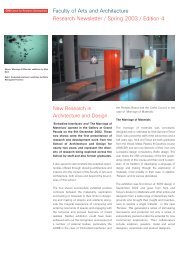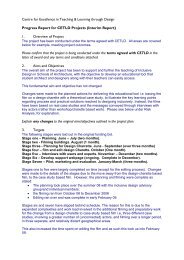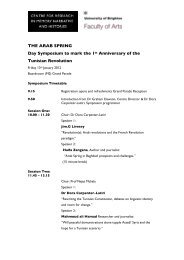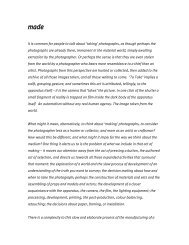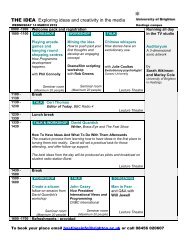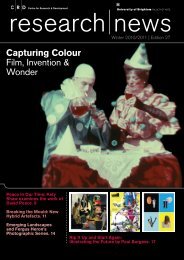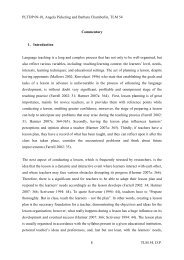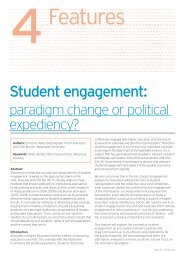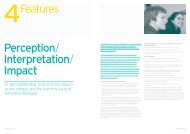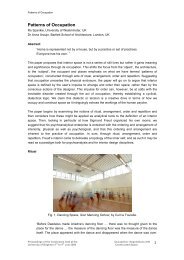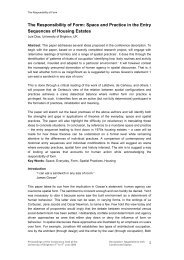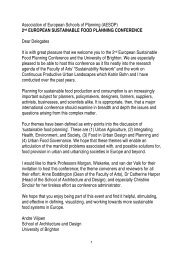Eleonora Lupo & Gennaro Postiglione 'Temporary Active'
Eleonora Lupo & Gennaro Postiglione 'Temporary Active'
Eleonora Lupo & Gennaro Postiglione 'Temporary Active'
Create successful ePaper yourself
Turn your PDF publications into a flip-book with our unique Google optimized e-Paper software.
Temporary Active<br />
1 Temporary Active - Actions as Urban re-appropriation<br />
strategies<br />
<strong>Eleonora</strong> <strong>Lupo</strong>, Politecnico di Milano, Italy<br />
<strong>Gennaro</strong> <strong>Postiglione</strong>, Politecnico di Milano, Italy<br />
Abstract: Erasure from collective memory of the image, presence and vitality of an urban<br />
space is a painful act. Reasons for such dissolutions are multiple: ideology, alteration,<br />
progress and change in general. Architects and designers have a mission to properly<br />
question this erasure and they can develop the capacity to use it as a powerful source of<br />
creativity.<br />
This paper focuses on forgotten urban spaces (mainly those that have been neglected or<br />
written off), and explores ways of revitalising them using methods of identification, analysis<br />
and temporary architectural projects. These urban spaces may each be quite different:<br />
consisting of a mixture of squares, streets, unoccupied buildings and/or abandoned plots,<br />
small and large sites or industrial compounds and so on. Observation and analysis a allow<br />
focus on the catalogue of problems and consequently, proposals for recovery often emerge<br />
along with possible means of intervention. These processes reveal a diversity of cases and<br />
approaches that bear witness to the cultural richness embedded in the hidden realms of<br />
collective memory. In this century, overwhelmed as it is by image, information and dynamism,<br />
it is particularly important for architects and designers to take on the special role of managing<br />
the creative recovery of forgotten spaces.<br />
Temporary Active - Actions as Urban re-appropriation strategies<br />
“A minor geography”: enabling practices for city social construction 1<br />
The urban and metropolitan landscape is no longer defined as a "secure and stable place of<br />
contemplation, but presents itself as a mobile device that is continually altered" (Gravano,<br />
2008). Looking at our cities, it is possible to see weak but constant upheavals that tend to<br />
make forms of resistance explicit and visible, including a range of urban activities. Of such<br />
practices it is historically possible to identify a number of cultural models. The appropriation of<br />
public spaces by the Parisian flaneur with his walks through labyrinthine passages,<br />
(converting the streets into interieur), is one such model. Similarly, the Situationist<br />
International ‘drifts’, using maps and topography of transitional spaces, not just to "fix"<br />
territory, but to change it too. In the process, they planned to radically transform the essential<br />
structures, of architecture and city planning, through subjective perceptual experience<br />
(Debord, 1958).<br />
In the contemporary world, active ‘practice’ of metropolitan space has become more structural<br />
and more involved and widespread, with a view that is necessarily welcoming and inclusive.<br />
The city is increasingly seen as an experiential field (Scotini, 2003) and the processes of<br />
reading, interpreting and implementing opportunities offered by the urban context have<br />
become more mature, more culturally aware, and sensitive. Meta-design actions, are aimed<br />
at a recognition of the value and potential of public spaces, through a descriptive approach<br />
(Dematteis, 1995) of reading, decoding and ‘context providing’ 2 . More proper planning actions<br />
may then be aimed at activating these spaces. In this way, dismissed or forgotten spaces,<br />
Proceedings of the Conference held at the Occupation: Negotiations with<br />
University of Brighton 2 nd to 4 th July 2009 Constructed Space<br />
1
Temporary Active<br />
abandoned places and unused areas, change from being "swamp-like places" outside of<br />
official maps, to become paradigmatic examples of urban spaces, filled with meaning, value,<br />
shape, and opportunities for creative re- signification and appropriation by the city.<br />
These actions of occupation, appropriation and activation often tend to draw a “minor<br />
geography” in the urban fabric, capable of giving visibility and response to the needs and<br />
forgotten desires of an “insurgent” city looking for structures. This should not be understood in<br />
an exclusively subversive or protesting sense, but as a collective intentionality, careful to offer<br />
multiple points of view and to give voice to communities that would otherwise be invisible. In<br />
this way, people, culture and places are connected in a common “discourse” about the social<br />
construction of the city, its identity and memory, through the rehabilitation of lost or deleted<br />
tracks and abandoned places. According to Richard Sennett, communities “make uses of<br />
disorder” to trigger their personal identity in city life (Sennett, 1970).<br />
For this very reason, however, it is important to understand that these processes are far from<br />
being voluntarily negotiated. Left adrift, they are often layered onto the existing city in a<br />
pervasive but isolated way, creating differences, fractures and urban “solitude” (an autonomy<br />
that could lead to tension), rather than plural identities. Conversely, if regimented in<br />
processes that tend towards standards or control, they progressively lose their charge of<br />
vitality and experimentation. It is therefore necessary to map the best experiences currently<br />
ongoing and to enable these processes through the planning of design strategies. On the one<br />
hand, we must develop a paradigm of coexistence between the new and the existing,<br />
establishing relationships in the urban fabric, and on the other hand we must turn to<br />
participatory design tools and active listening (Sclavi 2003, 2007) which stimulate but<br />
especially empower community participation in the practices of city use, while respecting<br />
diversity.<br />
The processes of city social construction and re-signification can take on a positive aspect, in<br />
terms of their negotiations and sustainability, if they are leveraged onto individual and<br />
collective practice. They may create a dimension of urban participation, promote ownership<br />
and use of places and public spaces and foster collective design, relationships and the<br />
conscious expression of plural identities, all in a constant process of self-recognition and self-<br />
experimentation.<br />
They consist therefore, of a series of "relational-aesthetic acts" that involve people in the<br />
design of their cities through practices of art, design, architecture and city planning<br />
(Bourriaud, 1998). A set of practices, frequently of a temporary nature, that enable the<br />
formation of communities, places and identities. These are often empirical acts - precarious,<br />
situational or playful, but they are also capable of performing in and conforming to the space.<br />
All these experiences are indeed united by being planned actions in which the more or less<br />
temporary nature of intervention (from extemporaneous to semi-permanent), or performance,<br />
takes on a positive value capable of producing a lasting effect over time. Being designed<br />
interventions, even if temporary, they need some form of bond and commitment, (such as a<br />
spatial or economical gauge) that takes them closer to voluntary and conscious actions rather<br />
than to extemporaneous ones. Some of the most significant and distinctive qualities of these<br />
urban re-appropriation strategies in fact are:<br />
1. The ability to work (and therefore to produce significant impacts, in real time), through<br />
self-organization in “territorial laboratories” of networking involving a variety of social<br />
actors. Although the actions involved here mainly consist of temporary conversion,<br />
Proceedings of the Conference held at the Occupation: Negotiations with<br />
University of Brighton 2 nd to 4 th July 2009 Constructed Space<br />
2
Temporary Active<br />
recovery and reuse, they are capable of generating consequences that are not ephemeral<br />
but are permanent and consistent. Investing not so much in the physical and material<br />
realms but in the intangible aspects of community building (identity and sense of<br />
belonging) (refer to no. 8 – OUT and no 11 - PUBLIC DESIGN in image. 01).<br />
2. The ability to trigger innovative processes from social creativity, in other words by the<br />
collective involvement of people. These practices describe new subjective geographies in<br />
which the emphasis on the individual is associated with the potential of collective actions.<br />
They expand the concept of authorship to one of participation, in a worthy mixture of the<br />
private and the public dimensions (refer to no.11 –PARKingDAY or no. 16- PERMANENT<br />
BREAKFAST in image. 01).<br />
3. The emblematic nature and sustainability (especially relevant and distinctive for the focus of<br />
this paper) of a methodological process that is careful to pick out the weaker signals present<br />
in the environment. Particularly those that focus on the re-use of residual places, transit<br />
spaces and areas that are still only potentially significant within the dynamics of the city and<br />
the availability of urban resources. These are ‘void spaces’ that, in an extended meaning of<br />
the term, are the dismissed, derelict and abandoned spaces, not only in the sense of<br />
physical use and function, but even more importantly, in a metaphorical sense. They can<br />
become the main subject of the representation of possible and practicable development and<br />
exploitation of scenarios. In this sense, they are also applicable to the recovery of small<br />
towns that are subject to abandonment and depopulation. (refer to no.14 –OSSERVATORIO<br />
NOMADE and no.19 –CAIRO REPAIRING CITY in image. 01).<br />
4. The various processes of the recovery of “empty spaces”, and their activation involve a<br />
variety of goals and scales of action, which range from acts of pure challenge to advocacy<br />
and empowerment activities using a sort of “repairing process” of infrastructural facilities.<br />
(Navarra, 2008). These interventions are divided into (not necessarily consequential)<br />
actions of design, safety and maintenance (i. e. through decoration); the implementation<br />
and appreciation of aesthetic experiences related to the expressive qualities and<br />
communicative vocation of a place (refer to no.15 –ADD ON and no. 6- GRAFFITI LAB in<br />
image. 01), and ultimately to the improvement of the use value and functionalization of a<br />
place. (refer to no.13 –CABIN EXCHANGE and no.18- PARTY PLATFORM in image. 01).<br />
5. The multiple approaches and techniques of intervention that are introduced through a<br />
fusion of art, design and architecture using concepts of performance, urban happening,<br />
event or site-specific service to create, substantially bottom-up, “spaces of democracy”. On<br />
the one hand there is an approach that is in the arena of art, which includes conversational<br />
and public art references for the promotion of dialogue between aesthetic experience and<br />
collective poetic imagination. This approach encourages the innovative use of languages,<br />
technologies and behaviors (Zanfi, 2003, Birrozzi, Pugliese, 2007, Altarelli, 2006,<br />
Ottaviani, 2007, Galal, 2009) (refer to no. 2 –CITTàZIONI in image. 01). On the other hand<br />
there is guidance that makes social innovation practices, the design of collaborative<br />
services and public design the foundation of its action. This guidance operates in a context<br />
where cities and creative communities are platforms for the design of new collective social<br />
and cultural scenarios (Manzini, Jegou, 2008, Meroni, 2007, Carta, 2007, Landry, 2000)<br />
(refer to no.7 –GOING PUBLIC in image. 01).<br />
6. The potentiality of networking in a physical system of connections and relations including<br />
the use of technology and digital devices, ranging from virtual relief mapping of these<br />
dense places in the city (refer to no.9 –URBAN TAPESTRIES in image. 01), to their<br />
systematization into a diffused and connected structure of collaboration and cooperation.<br />
Proceedings of the Conference held at the Occupation: Negotiations with<br />
University of Brighton 2 nd to 4 th July 2009 Constructed Space<br />
3
Temporary Active<br />
We would particularly emphasize here that, rather than an artistic component per se, it is the<br />
aesthetic and relational value, which gives force to these interventions and underlines their<br />
political vocation. This is because they are potentially perceived as “soft” actions that do not<br />
impose deliberate transformations, but simply make them possible. They provide structures<br />
and contexts that allow the hybridization of institutional projects to become self-produced and<br />
more spontaneous activities. They manage to be disruptive and effective in generating<br />
positive changes, ranging from the re-functionalization of places to a better integration and<br />
social cohesion.<br />
Image. 01- Map of occupation-appropriation creative practices 3<br />
There are many contemporary examples of public design and public art that have an enabling<br />
and participatory approach in collective areas. In these actions, the public space becomes a<br />
new means of exchange and recognition through the metaphor of the (not) common place,<br />
understood as a space full of memories and meanings determined by individual and social<br />
relations. These places are also understood as shared places where different cultural<br />
instances, also find a field of comparison and encounter while at the same time respecting<br />
differences.<br />
Proceedings of the Conference held at the Occupation: Negotiations with<br />
University of Brighton 2 nd to 4 th July 2009 Constructed Space<br />
4
Temporary Active<br />
In these experiences the creative appropriation and occupation of space becomes a social<br />
engine of the community. It is a logic that moves the action from a simple location in the<br />
community, to an asset for the community and with the community, which in itself creates<br />
community (Toscano, 2004). Interventions use a perspective of social empowerment, with<br />
emphasis on self-determination and the recovery of individual and collective capacity. This is<br />
“in opposition to a system that requires inspection and approval” (Pietromarchi, 2005). The<br />
city becomes an “interacting system of multicultural communities, capable of expressing<br />
different forms of urban life” and permitting the coexistence of the material city along side the<br />
intangible city of flows and relationships.<br />
The concept of temporary is conceived as a positive idea of improvisation and approximation<br />
in which the values and characteristics of lightness, transience, mobility and instability reflect<br />
a condition of freedom for experimentation and cultural cohabitation. A city centered on<br />
humans and set up at a human scale. The notion of exhibition and setting up has become a<br />
metaphor for the reversibility and convertibility of a contemporary “light city” (Altarelli, 2006),<br />
potentially democratic activities and facilities are set in place to encourage opportunities for<br />
reuse. These facilities are collected together in a list of “dot-actions” 4 from which national<br />
governments and private citizens can freely draw inspiration. In this sense, processes of<br />
appropriation are real incubators for a “creative city” (Landry, 2000), whose success will be<br />
determined by the ability to recreate a sense of citizenship (the genius loci, the continuity of<br />
traditions, security and the ability to imagine the future) and simultaneously maximizing some<br />
specific opportunities to create real networks of local identities (Carta, 2004, 2007).<br />
Berlin: a Case Study 5<br />
Berlin is emblematic for the observation of contemporary strategies of urban appropriation. It<br />
can be seen, from an unconventional point of view, as a pathway of bubbles emerging from a<br />
lively and creative fabric of the metropolis’ forgotten spaces. A view from the inside out, as if<br />
from behind the curtains of the city. Such spaces are already a fertile ground for the<br />
apparently chaotic generation of temporary activities that actually stem from active<br />
involvement of the dwellers recapturing their own city. Berlin is nowadays a reference for<br />
proposing and arranging an exemplary new colonization of these spaces.<br />
Strolling along the streets of Berlin today it is impossible to ignore the presence of empty<br />
spaces. They just catch the eye by their apparent ‘non-existence’, caused by destruction or<br />
non-construction. Such spatial particles are spread out in a capillary manner, and each of the<br />
different scattered spaces has a lot in common. They lack functionality, being made up of raw<br />
material that can be identified in their simple structure or skeleton and they have an<br />
immediate visual impact and therefore a potentially direct accessibility. They serve no<br />
purpose, as non-built grounds, abandoned places, dismissed spaces or simply temporary<br />
pauses between building phases. Their origin usually lies in the bombing of World War II, and<br />
later they were only partially filled during the following a reconstruction based on previously<br />
existing schemes. They are raw material, being marked off by surrounding objects only, by<br />
the blind walls of neighbouring buildings that unmistakably define their presence. Such<br />
elements constitute an external skeleton, an almost supporting structure for new proposals.<br />
The basic material is neglected ground, where nature slowly re-conquers its position. These<br />
spaces do have an immediate visual impact, as open wounds very easily spotted among<br />
existing buildings, as brutal interruptions of the construction continuum and as gaps or holes<br />
that allow a peek into what is happening inside the block. They invite us to follow our glance<br />
Proceedings of the Conference held at the Occupation: Negotiations with<br />
University of Brighton 2 nd to 4 th July 2009 Constructed Space<br />
5
Temporary Active<br />
and enter.<br />
Some of these empty spaces host structures that temporarily occupy them. Architectures<br />
conceived not for filling up empty rooms, but rather for repossessing them and giving them<br />
back life and function as public spaces or meeting spaces. The common rationale consists in<br />
injecting new meanings into these spaces, while waiting for a permanent occupation. This<br />
rationale follows the stream of the spontaneous phenomenon of temporary activity –<br />
stimulating action, furnishing the spaces and making them newly available.<br />
Being aware of this, a field research workshop has been organized to study the repossession<br />
of urban space by means of different techniques. Interviews, videos, pictures, canonical<br />
architectural representations, and any other form useful for narrating all the slight<br />
transformations that characterize several abandoned spaces in Berlin. So, a short journey<br />
within this network of well-rooted activities has been planned and developed, in order to<br />
comprehend the very sociality of the functions that manifest themselves each time which have<br />
proved to be vital to generate interaction among people.<br />
As a result, a catalogue of examples has been produced from the survey. The interventions<br />
are varied; they can be movable or rooted, reversible, modifiable or adjustable to different<br />
uses, according to the success of the activities or to their destination on the ground. The city<br />
of Berlin has made available innumerable and well-established temporary and spontaneous<br />
initiatives, that have been generating real and tangible do-it-yourself cultures through the last<br />
decades. The identification and mapping of these strategies for gradually giving back life to<br />
the spaces, carried out by the users, shows a particular and promising cultural substrate of<br />
enabling that does not have to go through the channels defined by “classic” planning, which<br />
on the contrary is aimed at an immediate achievement of a finished product. We believe that<br />
telling a story about the life of these places, exploring, investigating and mapping them with<br />
the eyes of those who lived them, even for a few moments, has been really inspiring and<br />
helpful for other processes of appropriation.<br />
Our mapping presents cases of urban empty spaces, that would otherwise remain<br />
unexploited, which are now used to give room for initiatives by citizens. These are in a<br />
context where owners and potential users are accustomed to the idea of using spaces in a<br />
non-permanent way with mutual benefits. In addition, since temporary use contracts exist<br />
and are stipulated in Berlin, citizens have a chance of realizing their ideas in a simple and<br />
legal manner. We present here only three paradigmatic examples, quoting their processes of<br />
start-up and realization and their results and impact on the local territory as exemplary of the<br />
overall catalogue.<br />
1. Ein platz fur Marie<br />
Process & goals: In the place of a demolished fire station in the area of Prenzlauer Berg,<br />
some citizens, formed an association and, supported by local residents, proposed to re-<br />
functionalize the area by establishing in 1998, a children’s playground and park. They<br />
negotiated a temporary use contract with the landowner, lasting ten years, with the<br />
approval of the institutional local district body. One architecture studio has been involved<br />
to assist the residents in designing the activities for a 0-12 year old kids playground, and<br />
post school activities including sports and creativity laboratories.<br />
Approach & Results: The intervention focused on providing a public service and with the help<br />
of private backers, supplied the infrastructure to make the playground available. Having<br />
been a really successful initiative, after ten years, the temporary contract was renewed in<br />
Proceedings of the Conference held at the Occupation: Negotiations with<br />
University of Brighton 2 nd to 4 th July 2009 Constructed Space<br />
6
Temporary Active<br />
2008 for the following ten years., The area was extended and the park was further<br />
implemented for the addition of children up to 16 years of age.<br />
Impact: In the surrounding neighbourhoods, different initiatives and various other playgrounds<br />
have been realized based on the experience of Marie’s park and a district association<br />
called Netzwerk has been founded with the mission of qualifying public spaces for the use<br />
of people, generating an impact both on both physical and intangible aspects of<br />
intervention, especially in the creation of a potential network of children’s parks.<br />
Image. 02- Ein Platz fur Marie, Berlin<br />
2. Rosa Rose Garten<br />
Process & goals: a neighbourhood garden was conceived by the local community and<br />
district in an area close to Friedrichshain, previously occupied by social housing<br />
(demolished) and squatted apartments. This project was initiated when the municipality<br />
decided to entitle the use of the occupied houses and to clean up the area. The community<br />
garden was completely designed and realized by local people and equipped with different<br />
structures such as gazebos, a public oven and a well, in order to allow for a range of<br />
activities, which included parties and playgrounds along with gardening.<br />
Approach & Results: The area is now divided in two parts that are mainly conceived to<br />
provide simple social platforms, more than services. Thanks to the minimal infrastructures<br />
at their disposal, people can use the area freely to organize collective dining, barbeques,<br />
children’s parties and so on. They use the internet to share initiatives with each other and<br />
to invite friends.<br />
Impact: The laying of a simple fence has provided both protection and an incentive for the use<br />
of the area that is now lively and very well frequented, especially in summer. So this can<br />
also be an example of the need for identifying a first space appropriation element<br />
(temporary and movable) as a “declarative” starting point for the process.<br />
Proceedings of the Conference held at the Occupation: Negotiations with<br />
University of Brighton 2 nd to 4 th July 2009 Constructed Space<br />
7
Temporary Active<br />
Image. 03- Rosa Rose Garten, Berlin<br />
3. Wagendorf Lohmuhle<br />
Process & goals: In the place of an abandoned area resulting from the demolition of the Berlin<br />
wall and previously occupied by illegal camp structures, the initial occupants negotiated<br />
the possibility of providing collective aggregation activities for the surrounding residents<br />
with the municipality, in exchange for getting the use of the area for ten years. They were<br />
also authorized to establish an alternative social housing village to enlarge the<br />
community and reinforce the dialogue with the district residents.<br />
Approach & Results: This activation process experimented both with the use of artistic and<br />
cultural interventions and the creation of social services. The use of self-constructed and<br />
low budget temporary structures supported the definition and provision of a very<br />
articulated program of cultural and artistic activities, called “Experimentcity” and divided<br />
into permanent (cinema, concerts), temporary (theatre, artistic events) and<br />
extemporaneous ones (special events). They used abandoned railway coaches still<br />
available in the area from the time of the pre-existing train station, as part of a low cost<br />
strategy to equip the area with temporary residences.<br />
Impact: The experimentation aroused the interest and participation of the surrounding residents,<br />
demonstrating the possibility of a democratic and pacific co-existence driven by a realm of<br />
social creativity and innovation by collective involvement. As a result of this initiative, a<br />
cultural association called Kultur has been founded.<br />
Proceedings of the Conference held at the Occupation: Negotiations with<br />
University of Brighton 2 nd to 4 th July 2009 Constructed Space<br />
8
Temporary Active<br />
Image. 04- Wagendorf Lohmuhle, Berlin<br />
Conclusion 6<br />
Evaluating these examples and case studies, we observe that a substantial length of time is<br />
needed to embed those processes in the existing context in an integrated and non-hostile<br />
way and to settle them as successful participative strategies. Because social and cultural<br />
changes often require processes of negotiation and a longer time frame than is generally<br />
acceptable to a community, it is necessary to make them synchronic for people’s<br />
understanding.<br />
Involving the City Council as a mediator between owners and users can be a winning<br />
strategy. In order to be a valid proposal from the point of view of the city administration, the<br />
result of a temporary exploitation process must be of a high quality, hence the idea of an<br />
architectural tender for the available spaces. Once tested and verified, according to the<br />
citizens’ needs and requirements, the temporary reuse process initiated by a local community<br />
and supported by a municipality could be standardized so that it may be executed in different<br />
places. The following seven steps should always be included: Identification, Information,<br />
Consultation, Decision making, Summoning, Executing, Substituting.<br />
These seven steps may evolve as verification of the process to be set in place for a possible<br />
temporary use. They also emphasise diversification, which in turn will lead to a combinatory<br />
opportunity for spatial and environmental situations. An ample array of exploitation options is<br />
configured by coordinating equipment systems and available surfaces.<br />
In such a process, designers and architects may play a significant role as building agents of a<br />
shared identity. They have the opportunity to use their training and skills to foster ethical<br />
awareness, reflection, commitment and responsibility in processes that lead to the, unveiling<br />
of issues and real problems, for the collective consciousness.<br />
Proceedings of the Conference held at the Occupation: Negotiations with<br />
University of Brighton 2 nd to 4 th July 2009 Constructed Space<br />
9
Temporary Active<br />
Endnotes<br />
1 This section was compiled by <strong>Eleonora</strong> <strong>Lupo</strong>.<br />
2 By context providing we mean a creative process able to produce a context; it is a device<br />
producing opportunities solutions and contents.<br />
3 For reference to the examples in the map see the web Reference at the end of the paper.<br />
4 In Italian facilities or equipment can be translated with the word "dotazione", that has an<br />
assonance with the world "azione", meaning action. There is a play on words that sounds like<br />
"facility for action" or better "dowry for action", that gets lost in translation. We propose the<br />
term dot-actions in this sense of tools for/points of action.<br />
5 This section was compiled by <strong>Gennaro</strong> <strong>Postiglione</strong>, as a result of an urban exploration<br />
workshop organized in November 2007. Students at the Faculty of Architecture and Society of<br />
the Politecnico di Milano also participated: Marta Balestrieri, Alessio Casiraghi, Maria Soo-<br />
Ran Accorsi, Francesca Guarascio, Alberto Clerici, Paola Di Salvo, Sirene Papadimistru,<br />
Maria Elena Soriero, Benedetta Sartori, Giulia Urciuoli, Andrea Pezzoli, Claudia Moranti,<br />
marta Vitali, Roberta Filippini, Alessandro Colli, maria Luisa Daglia, Matteo Perin, Silvia<br />
Fanoni, Federico Cabrini. Senior students Gabriele Corbetta and Benedetta Cremaschi<br />
cooperated in organizing the workshop, while Agostino Petrillo, Urban Sociology professor,<br />
contributed to the development of explorations by the students.<br />
6 This section has been compiled by <strong>Eleonora</strong> <strong>Lupo</strong> and <strong>Gennaro</strong> <strong>Postiglione</strong>.<br />
References<br />
Altarelli L. (2006), Light City, Meltemi, Roma<br />
Altarelli L. Ottaviani R. (ed. by) (2007), Il sublime urbano. Architettura e new media, Gruppo<br />
Mancosu editore, Roma.<br />
Birrozzi C. Pugliese M. (ed. by) (2007), L’arte pubblica nello spazio urbano. Committenti,<br />
artisti, fruitori,<br />
Bruno Mondatori, Milano.<br />
Bishop Claire (ed. by) (2006), Participation, Whitechapel/MitPress, London.<br />
Boeri S. (2001), USE-uncertain states of Europe, Skira, Milano.<br />
Bourriaud N. (1998), Esthetique relationelle, Les presses du reel, Dijon.<br />
Brugnara M., Castiglioni F. (2005), Le iniziative degli abitanti del quartiere isola, in “Ananke”<br />
No. 4, Alinea, Firenze.<br />
Bruno G. (2009), Pubbliche intimità, Bruno Mondatori, Milano.<br />
Burns A.(2000), “Emotion and urban experience: implication for design”, in Design Issues,<br />
Vol. 16, No. 3<br />
Carta M. (2004), Next City, Culture City, Meltemi, Roma.<br />
Carta M. (2007), Creative City. Dynamics, Innovations, Actions, List, Barcelona.<br />
Desideri P., Ilardi M. (1998), Attraversamenti. I nuovi territori dello spazio pubblico, Costa &<br />
Nolan, Milano.<br />
Debord G. (1958), “Teoria della Deriva” in AA.VV., Internazionale situazionista 1958-69,<br />
Nautilus, Torino 1994 (ed. it. a cura di Lippolis M.)<br />
Di Marzio M. (2003), Cittàzioni. Un caso di public art a milano, Silvana editoriale, Milano.<br />
Downing F. (2003), “Trascending memory: remembrance and design of place”, in Design Studies<br />
Vol. 24 No. 3<br />
Galal C. (2009), Street art, Auditorium, Palermo.<br />
Getz, D. (1997), Event Management and event tourism, Cognizant Communication, Elmsford.<br />
Proceedings of the Conference held at the Occupation: Negotiations with<br />
University of Brighton 2 nd to 4 th July 2009 Constructed Space<br />
10
Temporary Active<br />
Gravani V. (2008), Paesaggi attivi. Saggio contro la contemplazione, Costa&Nolan, Milano.<br />
Haydn F., Temel R. (2006), Temporary Urban Spaces. Concepts for the Use of City Spaces,<br />
Birkhauser Verlag, Basel.<br />
Kester Grant H. (2004), Conversation pieces. Community + communication in modern art,<br />
University of California Press, Berkeley.<br />
Landry C. (2000), The Creative City. A Toolkit for Urban Innovators, Earthscan, London.<br />
<strong>Lupo</strong> E. (2007), La cultura e il design come pratiche abilitanti di costruzione sociale della città,<br />
in “Passaggi”, Rivista Italiana di scienze transculturali, Carrocci editore/Fondazione Cecchini<br />
Pace, volume 14.<br />
<strong>Lupo</strong> E. (2008), “Progettare luoghi, territori, contesti. Una esperienza formativa e progettuale<br />
di meta-brand del territorio”, in Tafter Journal. Esperienze e strumenti per la cultura e per il<br />
territorio, No. 7.<br />
Lynch, K. (1960), The Image of the City, MIT Press, Cambridge, MA (USA).<br />
Manzini E., Jegou F. (2008), Collaborative services. Social innovation and design for<br />
sustainability, Polidesign, Milano.<br />
Meroni A. (2007), Creative Communities. People inventing sustainable ways of living, Polidesign,<br />
Milano.<br />
Miles M. (1997), Art, Space and the City: Public Art and Urban Futures, Routledge, New York.<br />
Navarra M. ( ed. by) (2008), Repairing city. La riparazione come strategia di sopravvivenza,<br />
Lettera Ventidue, Siracusa.<br />
Oswalt, P. (2000), Berlin_stadt ohne form. Strategien einer anderen Architektur, Prestel<br />
Verlag, München, London, New York.<br />
Paba, G. (1998), Luoghi comuni. La città come laboratorio di progetti collettivi, FrancoAngeli,<br />
Milano<br />
Pietromarchi B. (ed by) (2005), Il luogo (non) comune. Arte, spazio pubblico ed estetica<br />
urbana in Europa, Actar, Barcelona.<br />
Romano M. (2008), La città come opera d’arte, Einaudi, Torino.<br />
Sennett R. (1970), The uses of disorder: personal identity & city life, Norton Ltd., New York.<br />
Scarbi G. (ed. by) (2006), Less. Strategie alternative dell’abitare, 5Continents, Milano.<br />
Sclavi M. (2002), Avventure urbane. Progettare la città con gli abitanti, Elèuthera, Milano.<br />
Sclavi M. (2003), Arte di ascoltare e mondi possibili, Bruno Mondadori, Milano.<br />
Smith, K. (2007), The Guerrilla Art Kit, Princeton Architectural Press, New York.<br />
Scotini M. (ed. by) (2003), Networking city. Pratiche artistiche e trasformazione urbana,<br />
Maschietto editore, Firenze.<br />
Studio UC (2007), Urban Pioneers, Jovis Verlag.<br />
Toscano M. A. (2004), Per la socializzazione dei beni culturali, in Id., Sul Sud. Materiali per lo<br />
studio della cultura e dei beni culturali, Jaca Book, Milano.<br />
Weick, K. (1995), Sensemaking in Organizations, Sage Publications Inc., London.<br />
Zanfi C. (2003), Going public '03. Politics, subjects and places, Silvana Editoriale, Milano.<br />
Case studies References (web and bibliography)<br />
(with reference n° to the projects in the img. 01)<br />
Banksy street art: www.banksy.co.uk/ (1)<br />
BASE B- Zona Bovisa: http://www.zonabovisa.com (10)<br />
Camp for oppositional architecture: http://www.anarchitekture.com (21)<br />
Cittàzioni: http://undo.net/pressrelease/pdf/focus13.PDF (2)<br />
Community garden: http://www.greenguerillas.org (20)<br />
Proceedings of the Conference held at the Occupation: Negotiations with<br />
University of Brighton 2 nd to 4 th July 2009 Constructed Space<br />
11
Temporary Active<br />
Going Public: Zanfi C. (2003) Going public '03. Politics, subjects and places, Silvana<br />
Editoriale, Milano (7)<br />
LASER TAG- Graffiti Research Lab: http://graffitiresearchlab.com/ (6)<br />
LUCI D’ARTISTA, Torino: http://www.comune.torino.it/artecultura/luciartista/ (5)<br />
Osservatorio Nomade: http://www.stalkerlab.it/ - http://www.osservatorionomade.net/ (14)<br />
OUT-Office for Urban Transformation: http://www.isolartcenter.org/ (8)<br />
PARK(ing)DAY: http://www.parkingday.org/ (13)<br />
Party platform: http://keingeld.at/ (18)<br />
Permanent breakfast: http://www.p-breakfast.net/ (17)<br />
Public art: http://www.add-on.at (15)<br />
PUBLIC DESIGN-Esterni: http://www.designpubblico.it (11)<br />
Reclaim the streets!: http://rts.gn.apc.org/<br />
Repairing city: Navarra M. ( ed. by) (2008), Repairing city. La riparazione come strategia di<br />
sopravvivenza, Lettera Ventidue, Siracusa (19).<br />
Rooms for artists: http://www.cabinexchange.randomstate.org (13)<br />
TAZ: http://www.hermetic.com/bey/taz_cont.html<br />
Urban Cabaret: www.peprav.net/tool/IMG/pdf/12-15-URBAN_ACT.pdf (16)<br />
Urban Interior Occupation: http://www.urbaninterior.net/ - http://www.urbaninterior.net/berlin (<br />
(22)<br />
Urban tapestries: - http://urbantapestries.net/ (9)<br />
Zone attive: http://www.zoneattive.it/ (4)<br />
Proceedings of the Conference held at the Occupation: Negotiations with<br />
University of Brighton 2 nd to 4 th July 2009 Constructed Space<br />
12



